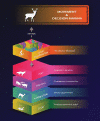The Olfactory Landscape Concept: A Key Source of Past, Present, and Future Information Driving Animal Movement and Decision-making
- PMID: 35923186
- PMCID: PMC9343233
- DOI: 10.1093/biosci/biac039
The Olfactory Landscape Concept: A Key Source of Past, Present, and Future Information Driving Animal Movement and Decision-making
Abstract
Odor is everywhere, emitted across the landscape from predators, prey, decaying carcasses, conspecifics, vegetation, surface water, and smoke. Many animals exploit odor to find food, avoid threats, and attract or judge potential mates. Here, we focus on odor in terrestrial ecosystems to introduce the concept of an olfactory landscape: real-time dynamic olfactory contours reflecting the patchy distribution of resources and risks, providing a key source of information used by many animals in their movement and decision-making. Incorporating the olfactory landscape into current frameworks of movement ecology and animal behavior will provide a mechanistic link to help answer significant questions about where, why, and when many animals move, and how they do so efficiently in both space and time. By understanding how animals use the olfactory landscape to make crucial decisions affecting their fitness, we can then manipulate the landscape to modify ecological interactions and, ultimately, ecosystem consequences of these interactions.
Keywords: animal movement; information; landscape ecology; odor; olfaction.
© The Author(s) 2022. Published by Oxford University Press on behalf of the American Institute of Biological Sciences.
Figures


Similar articles
-
Incorporating abiotic controls on animal movements in metacommunities.Ecology. 2021 Jul;102(7):e03365. doi: 10.1002/ecy.3365. Epub 2021 May 18. Ecology. 2021. PMID: 33871056
-
Landscape complexity persists as a critical source of bias in terrestrial animal home range estimation.Ecology. 2021 Aug;102(8):e03427. doi: 10.1002/ecy.3427. Epub 2021 Jul 12. Ecology. 2021. PMID: 34105787 Review.
-
Variation and drivers of airflow patterns associated with olfactory concealment and habitat selection.Ecology. 2018 Feb;99(2):289-299. doi: 10.1002/ecy.2102. Epub 2018 Jan 17. Ecology. 2018. PMID: 29341111
-
Toward a community ecology of landscapes: predicting multiple predator-prey interactions across geographic space.Ecology. 2017 Sep;98(9):2281-2292. doi: 10.1002/ecy.1916. Epub 2017 Aug 4. Ecology. 2017. PMID: 28585719
-
Migratory coupling between predators and prey.Nat Ecol Evol. 2018 Dec;2(12):1846-1853. doi: 10.1038/s41559-018-0711-3. Epub 2018 Nov 22. Nat Ecol Evol. 2018. PMID: 30467414 Review.
Cited by
-
Legacies of salient environmental experiences-insights from chemosensation.Chem Senses. 2024 Jan 1;49:bjae002. doi: 10.1093/chemse/bjae002. Chem Senses. 2024. PMID: 38219073 Free PMC article.
-
The deterrent effects of individual monoterpene odours on the dietary decisions of African elephants.Anim Cogn. 2023 Jun;26(3):1049-1063. doi: 10.1007/s10071-023-01755-4. Epub 2023 Feb 17. Anim Cogn. 2023. PMID: 36800131 Free PMC article.
-
Fine-scale associational effects: Single plant neighbours can alter susceptibility of focal plants to herbivores.PLoS One. 2025 Aug 21;20(8):e0330572. doi: 10.1371/journal.pone.0330572. eCollection 2025. PLoS One. 2025. PMID: 40839639 Free PMC article.
-
Comparing Durations of Different Countermeasure Efficacies Against Wild Boar (Sus scrofa) in Cornfields of Hunchun, Jilin Province, China.Animals (Basel). 2025 Apr 1;15(7):1017. doi: 10.3390/ani15071017. Animals (Basel). 2025. PMID: 40218409 Free PMC article.
-
The study of social animal migrations: a synthesis of the past and guidelines for future research.Proc Biol Sci. 2025 Jun;292(2049):20242726. doi: 10.1098/rspb.2024.2726. Epub 2025 Jun 18. Proc Biol Sci. 2025. PMID: 40527454 Free PMC article. Review.
References
-
- Abrahms B, Aikens EO, Armstrong JB, Deacy WW, Kauffman MJ, Merkle JA.. 2021. Emerging Perspectives on Resource Tracking and Animal Movement Ecology. Trends in Ecology & Evolution 36:308–320. - PubMed
-
- Atema J. 1996. Eddy chemotaxis and odor landscapes: exploration of nature with animal sensors. The Biological Bulletin 191:129–138. - PubMed
-
- Banks PB, Hume ID, Crowe O.. 1999. Behavioural, Morphological and Dietary Response of Rabbits to Predation Risk from Foxes. Oikos 85:247–256.
LinkOut - more resources
Full Text Sources
Miscellaneous

